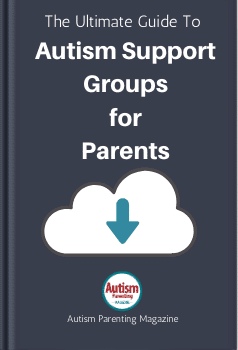Parenting an autistic child can be both deeply rewarding and incredibly demanding. Early on, I became fully immersed in meeting my children’s needs—coordinating therapy sessions, working on IEPs, and balancing the differing sensory needs within our family.
Days turned into a blur of appointments and routines, leaving little time for anything else. My life revolved around caregiving, and while I was grateful for every moment, I didn’t realize how quickly I was burning out.
Caregiver self-care is important when raising neurodivergent children. Burnout can sneak up on caregivers as they navigate the unique challenges of a neurodiverse household, but prioritizing self-care helps create the resilience needed to continue supporting loved ones.
Let’s explore ways to nurture ourselves, empowering us to sustain our energy and be present for our autistic children.

Download your FREE guide on
Autism Support Groups for Parents
Understanding caregiver burnout
Caregiver burnout is a state of physical, emotional, and mental exhaustion. It occurs when caregivers do not get the help they need or if they try to do more than they can do, either physically or financially.
For parents and caregivers of autistic children, the demands are not only relentless but also uniquely challenging, given the complex needs of our children.
Burnout goes beyond mere tiredness. It is the culmination of prolonged stress and fatigue that manifests in various detrimental ways.
Symptoms can range from physical signs like headaches and sleep disturbances to emotional symptoms such as feelings of detachment, reduced personal accomplishment, or loss of purpose.
The caregiving experience in the context of autism is unique. Many children with autism require constant supervision, specialized communication strategies, and tailored behavioral interventions.
These demands can significantly strain the caregiver’s resources and resilience. Add to that society’s misconceptions about autism and the lack of adequate support systems for many – it leaves caregivers feeling isolated and overwhelmed.
Signs of burnout in caregivers
Recognizing the signs of caregiver burnout is the first step toward addressing and mitigating its impact. Burnout can creep in subtly, manifesting through symptoms that may initially be dismissed as mere day-to-day stress.
However, when these symptoms persist or intensify, they serve as critical indicators that the caregiver needs to pause and seek support. Below are vital signs of burnout that caregivers, especially those caring for autistic children, should be aware of.
Physical signs
Physical signs include exhaustion, changes in sleep patterns, and new or worsening health issues. Feeling tired is one thing, but persistent exhaustion that doesn’t improve with rest is a hallmark of burnout. This can affect your ability to perform daily tasks and engage in activities you once enjoyed.

Difficulty falling or staying asleep, or experiencing restless nights are common. On the other hand, some find themselves sleeping more than usual as a form of escape.
When it comes to health, an increased susceptibility to colds, flu, and other illnesses can occur due to the immune system being compromised from continuous stress. Chronic pain, such as headaches and muscle aches, may also become prevalent.
Emotional signs
Emotional signs can include detachment, loss of motivation, and feelings of hopelessness. Emotional detachment can be from both your caregiver role and relationships.
This leaves you feeling numb or indifferent towards the needs of the person you care for. For many, tasks that once were a labor of love may now feel like an impossible chore.
Caregivers might need help to muster the energy or interest to engage in caregiving tasks. Hopelessness often plays out as a sense of despair or questioning whether your efforts make any difference, feeling trapped in your situation without any way out.
We often look for behavioral changes in our children and adjust their routines accordingly. However, we need to remember to watch for our behavioral changes.
Behavioral changes to keep an eye on include:
- a withdrawal from your social activities that leads to isolation,
- increased irritability,
- changes in your eating habits.
All caregivers need to remember that taking care of themselves is not selfish but necessary to continue providing the best care for their loved ones. The impact of caregiver burnout extends far beyond just the caregiver. It touches every aspect of their lives and those they care for.
Burnout can strain family dynamics, as the caregiver’s irritability, withdrawal, and exhaustion affect relationships with partners, other children, and friends. The emotional toll can create a cycle of guilt and frustration, trapped between the duty of care and the longing for relief.
Recognizing and addressing caregiver burnout is critical for the caregiver’s health and essential for maintaining a nurturing, supportive environment for the entire family.
Strategies for preventing and managing burnout
As an advocate and a parent of autistic children, I understand firsthand the complexities and challenges that come with caregiving.
Preventing and managing burnout is not just about survival; it’s about thriving in our roles as caregivers while ensuring we provide the best possible care for our autistic children.
Here are strategies that I’ve found invaluable in my journey and hope can serve as a guide for others.
Prioritize your well-being
Caregiver self-care is not selfish; it’s essential. Simple practices like ensuring enough sleep, eating a balanced diet, and engaging in regular physical activity can significantly impact your resilience and energy levels.
Carve out time for activities that rejuvenate your spirit, whether reading, gardening, or practicing mindfulness and meditation. Even five minutes daily focusing on something you enjoy can make a difference.
Set boundaries
Learn to say no to requests or obligations overextending your energy and time. Setting clear boundaries helps manage the demands placed on you, allowing you to conserve energy for your caregiving responsibilities and personal well-being.
Establishing a support network
Finding a community of fellow caregivers of autistic children can provide emotional support, practical advice, and a sense of belonging. Whether through local support groups or online forums, connecting with others who understand your experiences can be incredibly validating and empowering.

Download your FREE guide on
Autism Support Groups for Parents
Seek and accept help
Don’t hesitate to ask for and accept help from family, friends, or professional caregivers. Delegating tasks, whether caregiving or household chores, can provide you with much-needed respite and time to recharge.
Counseling and therapy
Engaging with a mental health professional can provide strategies to manage stress, cope with caregiving’s emotional demands, and address burnout feelings. Therapy can be a safe space to explore feelings and develop healthy coping mechanisms.
Respite care
Utilizing respite care services can offer a temporary break from caregiving duties, allowing you to rest and engage in self-care activities. This time can be crucial in preventing burnout and maintaining your well-being. Many communities offer programs to help reimburse respite care costs to families that qualify.
Embrace routine
Establishing a consistent daily routine can help manage your child’s expectations and your own, reducing stress and creating a sense of stability for the entire family.
Set realistic goals
Acknowledge and accept that you can’t do everything. Set achievable goals for yourself and your child, and celebrate the small victories. This mindset can help reduce feelings of inadequacy and frustration.
Practice mindfulness
Mindfulness can help you stay connected to the present moment, reducing anxiety and stress. This practice can be particularly helpful in managing the unpredictable nature of autism caregiving.

Managing caregiver burnout for a joyful autism journey
Incorporating these strategies into your life can help reduce the risks of burnout, allowing you to find joy and fulfillment in your caregiving journey. Remember, taking care of yourself is integral to providing the best care for your child. You are not alone in this journey; seeking help and support along the way is okay.
FAQs
Q: What are the signs of caregiver burnout?
A: Signs of caregiver burnout include chronic fatigue, irritability, anxiety, and feeling overwhelmed or detached from the person being cared for. Physical symptoms like headaches, changes in sleep patterns, and frequent illness are also common indicators.
Q: How can someone recover from caregiver burnout?
A: To recover, prioritize self-care by setting boundaries, taking regular breaks, and seeking support from friends, family, or support groups. Professional help, such as therapy or counseling, can also provide coping strategies and emotional relief.
Q: How long can caregiver burnout last?
A: The duration of caregiver burnout varies widely, lasting from a few weeks to several months, depending on the caregiver’s circumstances and support resources. Recovery is often gradual and depends on the availability of rest, help, and self-care.
Q: What does carer burnout look like?
A: Carer burnout may look like emotional exhaustion, withdrawal from loved ones, and decreased empathy or patience with the person they’re caring for. It can also manifest physically, with signs like fatigue, frequent illness, or neglect of personal health.
References
Simmons, D. M. (2023). Caregiver Burnout: What Are the Experiences of Burnout and Quality of Life of Caregivers Taking Care of Adults With Autism Spectrum Disorder? (Doctoral dissertation, Texas Wesleyan University). https://search.proquest.com/openview/c28a49b3cc98312300e53d04d00fd34b/1?pq-origsite=gscholar&cbl=18750&diss=y
Rodriguez, J. (2020). Effective Interventions in Reducing Caregiver Burnout in Parents of Children with Autism Spectrum Disorder. https://scholarworks.arcadia.edu/showcase/2020/psychology/21/
Singh, N. N., Lancioni, G. E., Medvedev, O. N., Hwang, Y. S., Myers, R. E., & Townshend, K. (2020). Using mindfulness to improve quality of life in caregivers of individuals with intellectual disabilities and autism spectrum disorder. International Journal of Developmental Disabilities, 66(5), 370-380. https://www.tandfonline.com/doi/abs/10.1080/20473869.2020.1827211
Gérain, P., & Zech, E. (2021). Do informal caregivers experience more burnout? A meta-analytic study. Psychology, Health & Medicine, 26(2), 145-161. https://www.tandfonline.com/doi/abs/10.1080/13548506.2020.1803372



